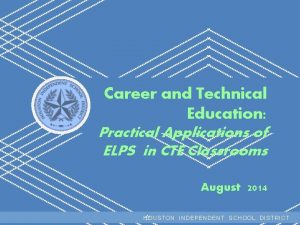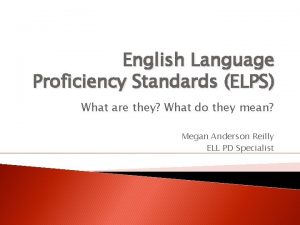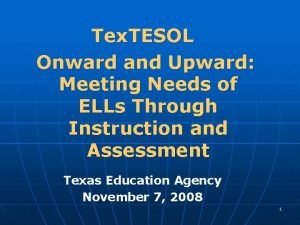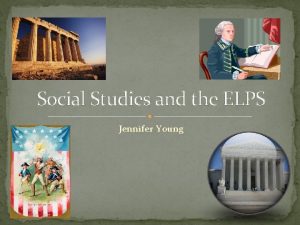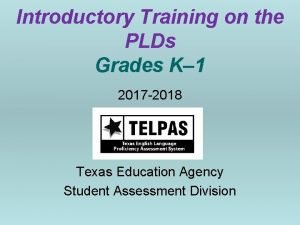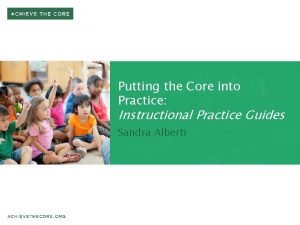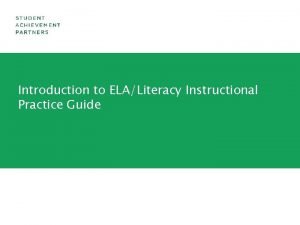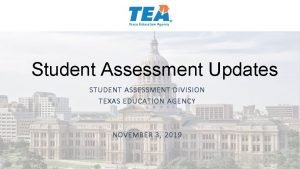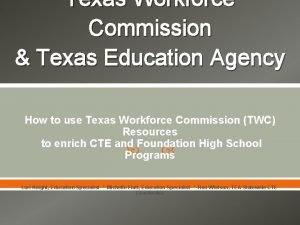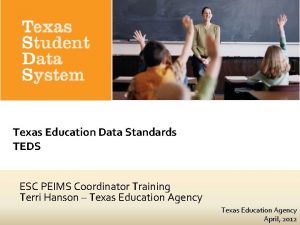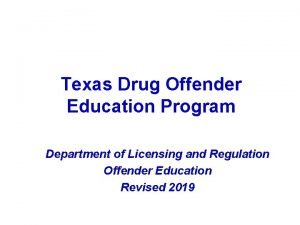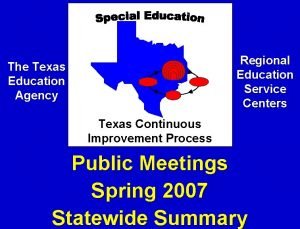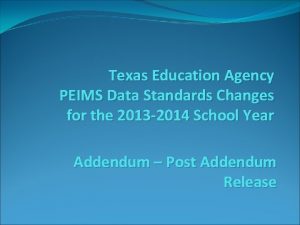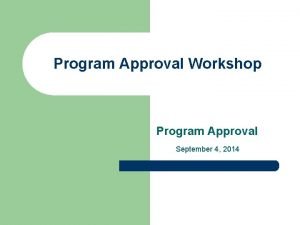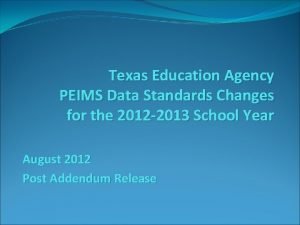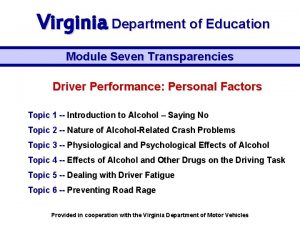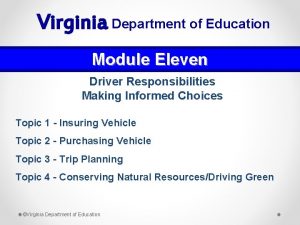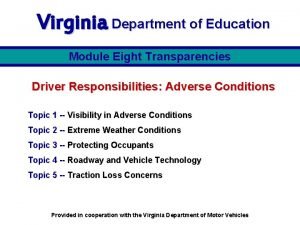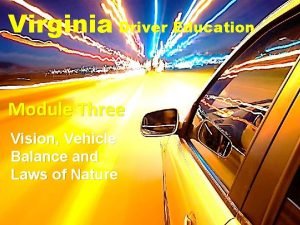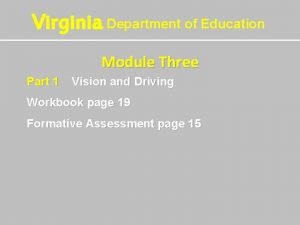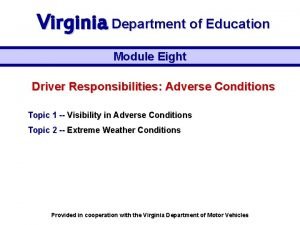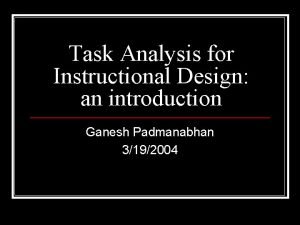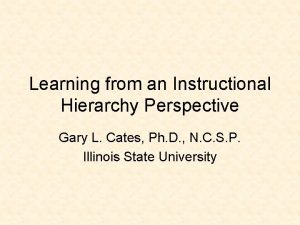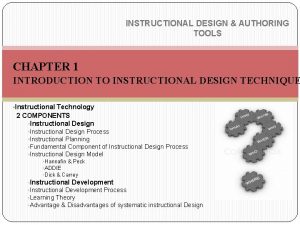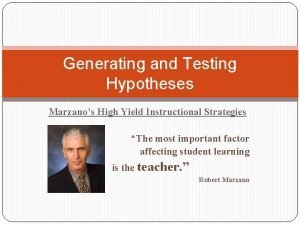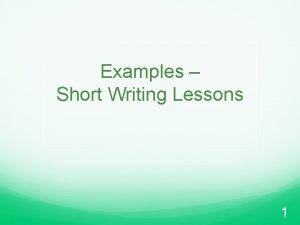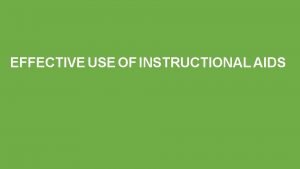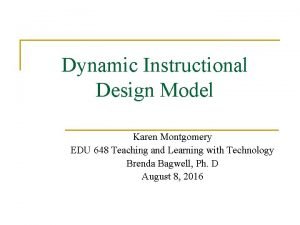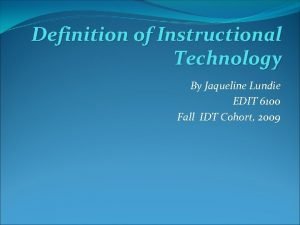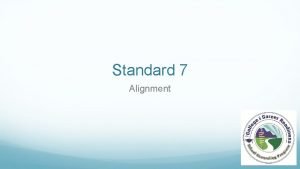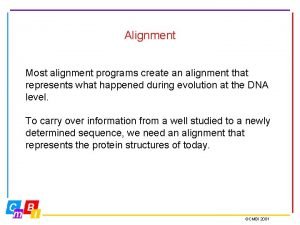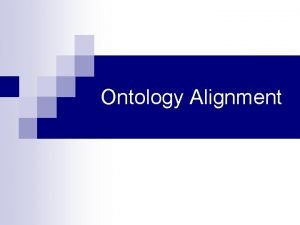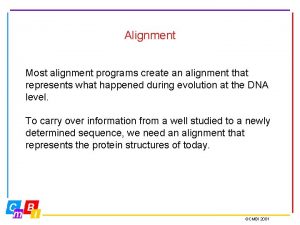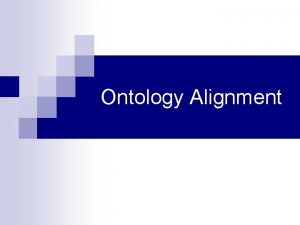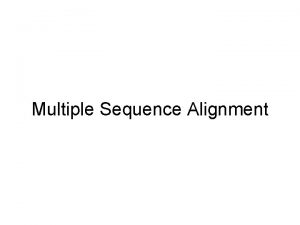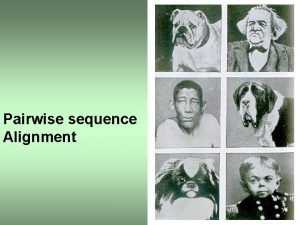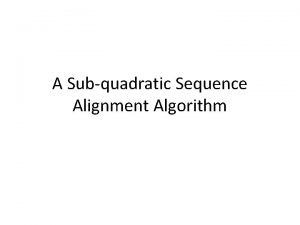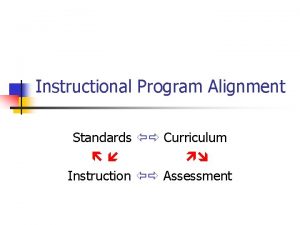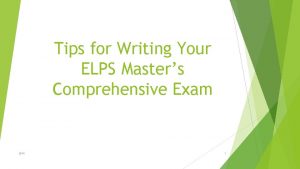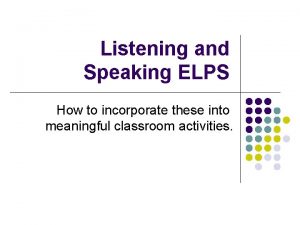Source ELPS Linguistic Instructional Alignment Guide Texas Education





















































- Slides: 53

Source: ELPS Linguistic Instructional Alignment Guide, Texas Education Agency ELPS AND THE LINGUISTIC INSTRUCTIONAL ALIGNMENT GUIDE Bilingual/ESL Instructional Services

Creating Language-Rich Interactive Environment Please. . . Today we will: � Speak in complete sentences � Avoid saying “I Don’t Know. ” Source: ELPS Linguistic Instructional Alignment Guide, Texas Education Agency

Training Goals Content Objective Explore the English Language Proficiency Standards, use a graphic organizer to list the main ideas in the ELPS. Explore the PLDs Explore the ELPS Linguistic Instructional Alignment Guide Language Objective Discuss the implementation of the ELPS and responsibilities for educators (74. 4 a, b) for providing K 12 th instruction based on the student’s linguistic needs and language proficiency levels. Source: ELPS Linguistic Instructional Alignment Guide, Texas Education Agency

Self-Assessment of Current Understanding Rate yourself on the following scale: 1. This will be my first exposure to the ELPS. 2. I am somewhat familiar with the ELPS. 3. I understand what the ELPS are and why they are significant to teachers. 4. I could explain to someone else what the ELPS are, how they are organized, and what they require of classroom teachers. Raise your hand when you have selected your response. I selected. . . because Source: ELPS Linguistic Instructional Alignment Guide, Texas Education Agency

Introduction to ELPS Framework and District Responsibilities We will explore the key components of the ELPS for providing K-12 instruction to ELL students. We will discuss the implementation of the ELPS reflecting on the responsibilities of ALL educators to linguistically accommodate instruction. Source: ELPS Linguistic Instructional Alignment Guide, Texas Education Agency

Foldable Process: Select some of the terms from the next “Word Wall”. You will discuss their meaning and complete the sentence stems by writing them in the corresponding columns I might be familiar with. . . ” “I will discover. . . ” …the term ELL … how to … “I have learned. . . ” … Source: ELPS Linguistic Instructional Alignment Guide, Texas Education Agency

Building Vocabulary (Word Wall) Foldable ELL: English Language Learner ELPS framework uses the words. . . LEP: Limited English Proficient q as a Second Language program Academic Language Linguistically Accommodated ESL: English q TELPAS: Texas q Communicated q Sequenced q Scaffolded English Language Proficiency Assessment System PLD: Proficiency Level Descriptor; rating of ELLs English skills Source: ELPS Linguistic Instructional Alignment Guide, Texas Education Agency

Language development standards before were. . . part of ELA and Spanish language TEKS. addressed only within ESL/Bilingual programs and only by ESL teachers. focused on knowledge and skills connected to English Language Arts. Language development standards now are. . . q q q part of every content in the required curriculum. addressed in all content by all teachers. focused on knowledge and skills connected to academic language development in the content areas. Source: ELPS Linguistic Instructional Alignment Guide, Texas Education Agency

Challenges English Language Learners (ELLs) Face Numbered Heads Together � At your tables, number off from 1 to 4. � Think of an ELL in your classroom. � Please stand when you can finish this phrase: One challenge English Language Learners face in the classroom is. . . � Beginning with number 1, share your sentence with your group. � When everyone has shared, you may be seated. Source: ELPS Linguistic Instructional Alignment Guide, Texas Education Agency

Why the ELPS? Use page 20 titled “Understanding the ELPS Framework: (1)” find “Why the ELPS? ” (In Resource Supplement). § Silently reflect on the statement you believe best represents the importance of the ELPS. § Stand up as soon as you have made your selection. § Find a partner from another table and discuss which statement you chose and why you selected it. Use the frame: I selected. . . because. . . Source: ELPS Linguistic Instructional Alignment Guide, Texas Education Agency

ELLs Benefit From. . . 1. content-area instruction that is accommodated to their need for comprehensible input. 2. academic language instruction integrated into content-area instruction. 3. programs that hold high expectations for students for academic success. 4. language proficiency standards that provide a common framework for integrating language and content instruction for English learners. How might the ELPS benefit students who are not ELLs? Source: ELPS Linguistic Instructional Alignment Guide, Texas Education Agency

ELPS Framework § § Chapter 74. 4 English Language Proficiency Standards Framework and summaries of ELPS Introduction, District Responsibilities, Student Expectations, and Proficiency Level Descriptors (subsection a, b, c, d) Source: ELPS Linguistic Instructional Alignment Guide, Texas Education Agency

Summary of ELPS Framework: (Use to take notes) (a) Big Ideas (b) Big Responsibilities (c) Student Expectations (d)Proficiency Level Descriptors Source: ELPS Linguistic Instructional Alignment Guide, Texas Education Agency

Getting Acquainted with ELPS PLD’s Matching Activity ELPS Proficiency Level Descriptors 2 nd-12 th * What ELLs are able to do based on language proficiency level. q Work in pairs. Use the template that shows the empty columns with the 4 language domains and the language proficiency levels. q Place the cards with the descriptors in the correct column/row. q Share your results! * There are ELPS Proficiency Level Descriptors for K-1 st grade Source: ELPS Linguistic Instructional Alignment Guide, Texas Education Agency

Understanding Chapter 74. 4. Subsection (a) Use page 4 from Resource Supplement. Find Ch. 74. 4 (a)(1) Highlight the second sentence of (a)(1) that begins, “School districts shall implement. . . “ � “ Highlight first sentence of (a)(2) “in order for ELL’s. . . ” � � Highlight the first sentence of (a)(3) that begins “Classroom instruction that effectively integrate. . . ” Draw a heart by a(3). What two things do teachers of ELLs need to integrate? Source: ELPS Linguistic Instructional Alignment Guide, Texas Education Agency

Curriculum Requirements Chapter 74. 4. (a) (6) The English language proficiency levels of beginning, intermediate, advanced, and advanced high are not grade-specific. ELLs may exhibit different proficiency levels within the language domains of listening, speaking, reading, and writing. The proficiency level descriptors outlined in subsection (d) of this section show the progression of second language acquisition form one proficiency level to the next and serve as a road map to help content area teachers instruct ELLS commensurate with student’s linguistic needs. Source: ELPS Linguistic Instructional Alignment Guide, Texas Education Agency

Curriculum Requirements Chapter 74. 4 (b)(1) Requires that school districts identify the student’s English language proficiency levels in the domains of listening, speaking, reading, and writing in accordance with the proficiency level descriptors for the beginning, intermediate, advanced, and advanced high levels. Source: ELPS Linguistic Instructional Alignment Guide, Texas Education Agency

Understanding subsection (b) District Responsibilities q Read section (b)(1). Highlight all the words of this section. Read section (b)(2). Highlight “linguistically accommodated (communicated, sequenced, and scaffolded commensurate with the student’s. . . ” Read section (b)(3). Highlight “skills in subsection (c)”. Read section (b)(4). Highlight “intensive, ongoing, foundational second language acquisition. . . In grade 3 or higher”. q Source: ELPS Linguistic Instructional Alignment Guide, Texas Education Agency

Teachers must. . . linguistically accommodate instruction. 74. 4: (b)(2) integrate language proficiency student expectations. 74. 4: (b)(3) be involved, as necessary, in intensive English language development for beginning and intermediate ELLs grade 3 or higher. § 74. 4: (b)(4) Read, reflect, share key points of chapter 74. 4 (b) Source: ELPS Linguistic Instructional Alignment Guide, Texas Education Agency

Linguistically Accommodated Instruction Supplementary materials (manipulatives, charts, realia) Instructional delivery Tasks based on the student’s current level of language proficiency Read p. 18 Summaries of ELPS. Subsections (a, b, c) Source: ELPS Linguistic Instructional Alignment Guide, Texas Education Agency

What Are Your Plans to Linguistically Accommodate Instruction? Read p. 18. Student expectations section of ELPS Resource supplement and highlight strategies and skills under each of the 4 domains that you will cover more this school year, and that maybe in the past you have not covered in depth. Think-Pair-Share Source: ELPS Linguistic Instructional Alignment Guide, Texas Education Agency

Using the Linguistic Instructional Alignment Guide See connections: q English Language Proficiency Standards (ELPS) q ELPS-TELPAS Proficiency Level Descriptors (PLD’S) q Linguistic Accommodations q College Career Readiness Standards (CCRS) Source: ELPS Linguistic Instructional Alignment Guide, Texas Education Agency

ELPS Linguistic Instructional Alignment Scavenger Hunt Source: ELPS Linguistic Instructional Alignment Guide, Texas Education Agency

ELPS Linguistic Instructional Alignment Guide Scavenger Hunt Use the Linguistic Instructional Alignment Guide to complete the Scavenger Hunt Worksheet. Source: ELPS Linguistic Instructional Alignment Guide, Texas Education Agency

Alignment of Components Partner A and B will. . . Explore the aligned components. Compare and contrast the similarities and differences between the K-1 st and the 2 nd-12 th grade Reading and Writing PLD’s. Find the linguistic accommodations. Describe the format to your partner. Source: ELPS Linguistic Instructional Alignment Guide, Texas Education Agency

Compare and Contrast PLD’s Work in groups: Create a graphic organizer to compare and contrast Compare and contrast the similarities and differences between the K-1 st and the 2 nd-12 th grade Reading and Writing PLD’s. Use the sentence stems to share your organizers: “One similarity I noticed between the K-1 and 2 -12 Reading PLD’s is. . . ” “One difference I noticed between the K-1 and 2 nd-12 Reading PLD’s is. . . ” “One similarity I noticed between the K-1 and 2 -12 Writing PLD’s is. . . ” “One difference I noticed between the K-1 and 2 -12 Writing PLD’s is. . . ” Source: ELPS Linguistic Instructional Alignment Guide, Texas Education Agency

Monitoring Progress The ELPS require that linguistic accommodations used during instruction be monitored and adjusted as needed during the school year as students reach higher proficiency levels and/or become familiar with the content. Source: ELPS Linguistic Instructional Alignment Guide, Texas Education Agency

ELPS-TELPAS Proficiency Level Descriptors Subsection (d) See p. 19 of Resource Supplement The PLD’s describe how well ELLs at each proficiency level are able to understand use English to engage in grade-appropriate academic instruction. There are separate PLD’s for listening speaking, reading and writing. Advanced High advanced intermediate beginning Best teaching practices Source: ELPS Linguistic Instructional Alignment Guide, Texas Education Agency

ELPS-TELPAS Proficiency Level Descriptors Chapter 74. 4 Subsection (d) These descriptors define the stages of second language acquisition and are called English language proficiency levels Now identify the ELPS -TELPAS PLDs for the rest of the language domains Source: ELPS Linguistic Instructional Alignment Guide, Texas Education Agency

ELPS Cross-Curricular Student Expectations(c) The ELPS Student Expectations integrate and focus on skills that support both social and academic language development Now identify the ELPS Cross Curricular Student Expectations for the remaining language domains. Source: ELPS Linguistic Instructional Alignment Guide, Texas Education Agency

Chapter 74. 4 (c)(3) Activity: Assign Language Domains Group by your assigned language domain (Listening, Speaking, Reading and Writing). In your assigned group, identify the ELPS that a Beginning and an Intermediate ELL may need then brainstorm a classroom activity that would promote language development. Source: ELPS Linguistic Instructional Alignment Guide, Texas Education Agency

College and Career Readiness Standards The CCRS represent a full range of knowledge and skills students are expected to know and be able to do, in order to succeed in entry-level college courses, as well as in a wide range of majors and careers. It is necessary that teachers consider these standards in instructional planning. Source: ELPS Linguistic Instructional Alignment Guide, Texas Education Agency

College and Career Readiness Standards The CCRS are aligned to each linguistic domain, and represent competencies and skills that graduating students must have to continue their education beyond high school. Now, identify the CCRS for the remaining language domains Source: ELPS Linguistic Instructional Alignment Guide, Texas Education Agency

Suggested Teacher Behaviors Linguistic accommodations are recommended language supports, which teachers incorporate as a means to make content area instruction accessible to ELLs. Now identify the Suggested Teacher Behaviors for the rest of the language domains Source: ELPS Linguistic Instructional Alignment Guide, Texas Education Agency

ELPS-TELPAS Proficiency Profile By listing student’s names according to their individual language ratings, student’s proficiency levels will be aligned to suggested linguistic accommodations. Source: ELPS Linguistic Instructional Alignment Guide, Texas Education Agency

Using TELPAS DATA The Confidential Student Report indicates the TELPAS proficiency ratings per language domain. Source: ELPS Linguistic Instructional Alignment Guide, Texas Education Agency

ELPS-TELPAS Proficiency Profile (I Do) Student 1 Source: ELPS Linguistic Instructional Alignment Guide, Texas Education Agency

ELPS-TELPAS Proficiency Profile (We Do) Student 1 Source: ELPS Linguistic Instructional Alignment Guide, Texas Education Agency

ELPS-TELPAS Proficiency Profile (You Do) Student 1 Source: ELPS Linguistic Instructional Alignment Guide, Texas Education Agency

ELPS-TELPAS Proficiency Profile (You Do) Student 1 Source: ELPS Linguistic Instructional Alignment Guide, Texas Education Agency

ELPS-TELPAS Proficiency Profile Utilizing the ELPS-TELPAS Proficiency Profile allows teachers to make meaningful instructional and linguistic decisions. Drive instruction Source: ELPS Linguistic Instructional Alignment Guide, Texas Education Agency

Using the LIAG to Write Lessons The ELPS Instructional Alignment Guide is designed to help teachers gather information needed to ensure that the classroom instruction meets the individual academic and linguistic needs of ELLs. Writing language and content objectives in a lesson will contribute to meeting the linguistic needs of ELL students. Source: ELPS Linguistic Instructional Alignment Guide, Texas Education Agency

Samples of Teacher Behavior for Developing Content Knowledge and Language Content Hands-on activities (labs) Graphic organizers Learning logs Realia/Models Multimedia presentations Providing native language resources and peer support Adapted texts Language Sentence starters Structured academic dialogues Modeling the use of academic language Writing/talking in complete sentences ELPS Resource Supplement. Teacher Behaviors p. 27, 31, 35, 39, 43, 47 Source: ELPS Linguistic Instructional Alignment Guide, Texas Education Agency

Performance-Based Activities These activities are recommended for teachers to implement in their instruction as ways to gather information on student progress. Source: ELPS Linguistic Instructional Alignment Guide, Texas Education Agency

Engaging Performance-Based Activities that Promote Language Development Science: Putting the Pieces Together-Connection Card Sort � Kinder-Needs of Organisms � 5 th grade-Phase Changes Math: Comparing Whole Numbers In A Conga Line 1 -5 th grade-Whole Numbers and Place Value Language Arts: Sequencing � 3 rd grade-Sequencing Words � 7 th grade-Point of View Social Studies: T-Chart, Pair, Defend � 4 th grade-Spanish Missions Source: ELPS Linguistic Instructional Alignment Guide, Texas Education Agency

Addressing the Needs of Beginning and Intermediate Students q How do I know ensure that I am addressing the beginning and intermediate students in my lessons? Linguistic accommodations for all lessons: q Go to p. 27 of ELPS Resource Supplement to ensure that teacher behaviors for beginner and intermediate students are implemented within the processes of any lesson. Source: ELPS Linguistic Instructional Alignment Guide, Texas Education Agency

Performance Base Lessons with Linguistic Accommodations for Beginner & Intermediate Work with a partner At your table there are sets of lessons for each content area. Pick a lesson to work with it. Look at the lesson’s processes (how). Use p. 27, 31, 35, 39, 43, 47 of the ELPS Resource Supplement on teacher behaviors for beginner and intermediate students Identify where you can place 2 of teacher behaviors from each domain into the processes of your selected lesson. Where would the behaviors go? Source: ELPS Linguistic Instructional Alignment Guide, Texas Education Agency

Share Out How does this lesson contribute to language development? Source: ELPS Linguistic Instructional Alignment Guide, Texas Education Agency

Suggested Performance-Based Listening/Speaking Activities Framed Oral Recap - use sentence stems to discuss what was learned: “Today I realized…, ” “Now I know…, ” or “The most important thing I learned was…” W. I. T. Questioning - promote elaboration in discussion, students use 3 stems (Seidlitz & Perryman, 2008): “What do you think…? ” “Is there another…? ” “Tell me more about…? ” Source: ELPS Linguistic Instructional Alignment Guide, Texas Education Agency

Suggested Performance-Based Reading Activities Partner Reading- Partners alternate reading a paragraph. One reads while the other summarizes and/or asks questions. Scanning- Student scan through text backwards looking for familiar terms. Teacher gives meaning of the terms as it appears in the context. Native Language Texts –Native language translations or summaries, wordlists, glossaries or related literature to support understanding Source: ELPS Linguistic Instructional Alignment Guide, Texas Education Agency

Suggested Performance-Based Writing Activities Graphic organizers – non-linguistic representations to organize information visually helps process and retain information. (Marzano, Pickering, 2001) Read, Write, Pair, Share – students read a text, write their thoughts on it using a sentence starter, pair up with another student, share their writing, and comment on one another's writing. (Fisher & Frey) Double Entry Journal – Using a 2 column journal, students write in the 1 st column, words, phrases, ideas that they find interesting. In the other, they write the reasons, or ways they can use them in their own writing. (Samway, 2006) Source: ELPS Linguistic Instructional Alignment Guide, Texas Education Agency

Using the LIAG to Write Lessons Effective instruction in second language acquisition involves providing ELLs opportunities to listen, speak, read and write at their current levels of English development while gradually increasing the linguistic complexity of the English they read, hear and are expected to speak and write. Source: ELPS Linguistic Instructional Alignment Guide, Texas Education Agency

Contact Information: Karina Chapa Director - Language Proficiency, Biliteracy, and Cultural Diversity kchapa@esc 1. net Perla Roerig Bilingual/ESL Specialist proerig@esc 1. net Program Assistant 956 -984 -6238 Division of Instructional Support
 Telpas descriptors
Telpas descriptors Elps standards texas
Elps standards texas Elps objectives
Elps objectives Compare two sequences
Compare two sequences Difference between local and global alignment
Difference between local and global alignment Sequence alignment
Sequence alignment Bioinformatics sequence alignment
Bioinformatics sequence alignment Global alignment vs local alignment
Global alignment vs local alignment Language proficiency
Language proficiency The elps student expectations focus on _______ development.
The elps student expectations focus on _______ development. How to write elps in lesson plans
How to write elps in lesson plans Telpas proficiency level descriptors
Telpas proficiency level descriptors Instructional practice guide math
Instructional practice guide math Instructional practice guide
Instructional practice guide Aqua texas inc
Aqua texas inc El paso texas travel guide
El paso texas travel guide Thsteps quick reference guide
Thsteps quick reference guide Tbpe ethics exam answers
Tbpe ethics exam answers Dccr texas education agency
Dccr texas education agency Sela texas education agency
Sela texas education agency Texas education agency jobs
Texas education agency jobs Texas women in higher education
Texas women in higher education Texas education data standards
Texas education data standards Texas drug offender education program test answers
Texas drug offender education program test answers Nursing organizational chart in hospital
Nursing organizational chart in hospital Texas regional education service centers
Texas regional education service centers Texas higher education coordinating board
Texas higher education coordinating board Texas education data standards
Texas education data standards Texas higher education coordinating board
Texas higher education coordinating board Msu texas financial aid
Msu texas financial aid Texas education data standards
Texas education data standards Texas education data standards
Texas education data standards Benefits of free and open source software
Benefits of free and open source software Module 10 topic 1 vehicle warning systems
Module 10 topic 1 vehicle warning systems Curriculum guide for driver education in virginia module 7
Curriculum guide for driver education in virginia module 7 Module 11 drivers ed virginia
Module 11 drivers ed virginia Module 8 topic 1 drivers ed
Module 8 topic 1 drivers ed Module 3 topic 4 basic maneuvering steering and braking
Module 3 topic 4 basic maneuvering steering and braking Lane position 1-4
Lane position 1-4 Module 5 curves hills and mountains
Module 5 curves hills and mountains Module 8 topic 1
Module 8 topic 1 Task analysis instructional design
Task analysis instructional design Tix instruction in sic
Tix instruction in sic Micro teaching conclusion
Micro teaching conclusion Maximizing instructional time in the classroom
Maximizing instructional time in the classroom Stages of instructional hierarchy
Stages of instructional hierarchy Marzano's 9 instructional strategies
Marzano's 9 instructional strategies Systematic design model by robert diamond
Systematic design model by robert diamond Instructional design authoring tools
Instructional design authoring tools Marzano 9 high yield strategies
Marzano 9 high yield strategies Instructional procedures examples
Instructional procedures examples Instructional aids examples
Instructional aids examples Dynamic instructional design model
Dynamic instructional design model Definition of instructional technology
Definition of instructional technology


